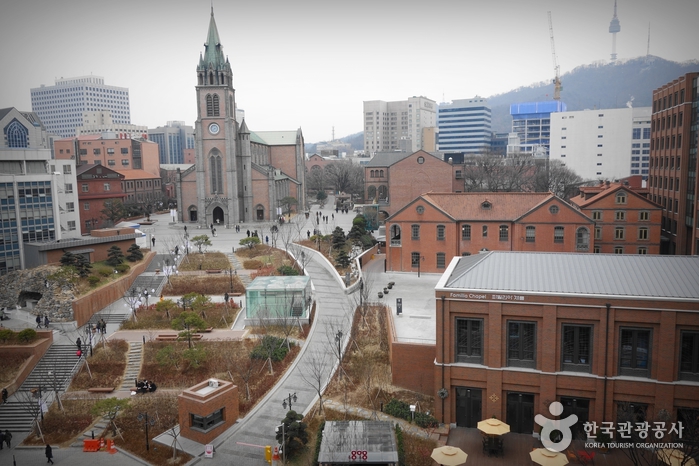Aimerfeel - Gangnam Branch (No. 2) [Tax Refund Shop] (에메필 강남2호점)
13.0Km 2024-06-27
396, Gangnam-daero, Gangnam-gu, Seoul
-
CheongKwanJang - Gwanghwamun Branch [Tax Refund Shop] (정관장 광화문)
13.0Km 2024-04-22
20, Sajik-ro 8-gil, Jongno-gu, Seoul
-
ATOP Plastic Surgery (에이탑 성형외과)
13.0Km 2025-10-23
4F-5F, 10 Gangnam-daero 94-gil, Gangnam-gu, Seoul
ATOP Plastic Surgery provides various beauty solutions, including fillers, Botox, lifting, laser treatments, skin care, and body contouring, all tailored to each individual’s needs. The clinic focuses on providing truly customized treatments for each patient, rather than one-size-fits-all procedures, to reveal and harmonize the patient's unique beauty and personality. Discover your true beauty and uniqueness through procedures customized for your face, just like finding the perfect outfit for your body.
Since its establishment, ATOP Plastic Surgery has performed approximately 50,000 procedures, with an average of 1,300 procedures per month. Based on this expertise, the clinic provides personalized procedures (e.g., fillers, Botox, lasers, etc.) for each customer. Every day, over 100 patients from around the world visit the clinic to enhance their beauty.
ATOP Plastic Surgery is committed to high-quality treatments, continuous research, and engaging in academic activities and social contributions.
Nice Weather Market [Tax Refund Shop] (나이스웨더마켓)
13.0Km 2024-06-26
35, Gangnam-daero 162-gil, Gangnam-gu, Seoul
-
Myeongdong Cathedral (서울 명동성당)
13.0Km 2022-12-27
74, Myeongdong-gil, Jung-gu, Seoul
Myeongdong Cathedral is the Church for Archdiocese of Seoul and was also the birthplace for the Roman Catholic Church community in Korea. The church houses the remains of several individuals: Bishop Laurent Joseph Marie Imbert (1796-1839), and priests Peter Simon (1803-1839), James (Jacques Honor Chastan, 1803-1839) and Pourthie Jean Antoine Charles (1830-1866) and four martyrs.
Myeongdong Cathedral is located in downtown Seoul and tourists frequently come and visit the place. Near the cathedral are other tourism spots such as Namsangol Hanok Village preserving Korean traditional houses, N Seoul Tower overlooking Seoul and Namdaemun Market, a traditional market with a wide variety of food and goods.
Tonymoly - Shinbundang Line Gangnam Branch [Tax Refund Shop] (토니모리 신분당선강남)
13.0Km 2024-04-22
Store #23, Gangnam Station Underground Shopping Center, 390, Gangnam-daero, Gangnam-gu, Seoul
-
Yeonsei ULINE Dental Clinic [Tax Refund Shop] (연세유라인치과병원)
13.0Km 2024-06-28
390, Gangnam-daero, Gangnam-gu, Seoul
-
Gangnam Arumdaun Nara Beauty Clinic (강남 아름다운나라 피부과)
13.0Km 2025-10-23
(12th Floor), 390 Gangnam-daero, Gangnam-gu, Seoul
Gangnam Arumdaun Nara Beauty Clinic has been at the forefront of Thermage technology, starting with the first-generation Thermacool in 2003, followed by the second-generation Thermage NXT, third-generation Thermage CPT, and the fourth-generation Thermage FLX.
The medical team at Gangnam Arumdaun Nara Beauty Clinic has published eight SCI-level papers related to Thermage, accounting for 10% of all Thermage-related research worldwide.
The clinic’s expertise in achieving effective lifting results without skin damage is due to continuous research and the skilled medical team.
The clinic offers its own skincare brand, Arumdaun Nara Cosmetics.
Lemon Mart - Myeong-dong Branch [Tax Refund Shop] (레몬마트 명동)
13.0Km 2024-04-17
1F, 45, Myeongdong 9-gil, Jung-gu, Seoul
-

![Aimerfeel [Tax Refund Shop] (에메필)](http://tong.visitkorea.or.kr/cms/resource/76/3313376_image2_1.jpg)
![CheongKwanJang - Gwanghwamun Branch [Tax Refund Shop] (정관장 광화문)](http://tong.visitkorea.or.kr/cms/resource/93/2889693_image2_1.jpg)
![Nice Weather Market [Tax Refund Shop] (나이스웨더마켓)](http://tong.visitkorea.or.kr/cms/resource/63/3313563_image2_1.jpg)

![Tonymoly - Shinbundang Line Gangnam Branch [Tax Refund Shop] (토니모리 신분당선강남)](http://tong.visitkorea.or.kr/cms/resource/59/2879959_image2_1.jpg)
![Yeonsei ULINE Dental Clinic [Tax Refund Shop] (연세유라인치과병원)](http://tong.visitkorea.or.kr/cms/resource/94/3312794_image2_1.jpg)
 English
English
 한국어
한국어 日本語
日本語 中文(简体)
中文(简体) Deutsch
Deutsch Français
Français Español
Español Русский
Русский